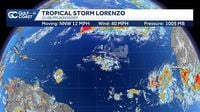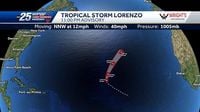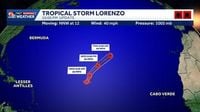Tropical Storm Lorenzo, the 12th named storm of the 2025 Atlantic hurricane season, is swirling through the open waters of the North Atlantic, drawing the close attention of meteorologists but, for now, sparing any land from its reach. According to the National Hurricane Center (NHC), Lorenzo formed early Monday, October 13, 2025, from a cluster of thunderstorms that had been designated as Invest 97L over the preceding weekend. As the storm gathered strength in the central tropical Atlantic, it quickly became a focal point for weather watchers across the globe.
At its peak, Lorenzo reached maximum sustained winds of 60 mph, according to a 5 p.m. update from the Hurricane Center, moving northwest at 15 mph. But by late Tuesday, October 14, 2025, the storm had begun to lose some of its punch. The NHC reported that Lorenzo was producing sustained winds of 40 mph and moving north-northwest at 12 mph. The forecast called for the storm to continue its northwesterly trajectory through Wednesday, then turn north overnight and begin a gradual weakening as it slid further north. Thankfully, Lorenzo is expected to remain far out at sea, posing no threat to land at any point in its lifespan.
Meteorologists from FOX Weather explained that Lorenzo would likely perform an elongated clockwise loop in the middle of the Atlantic Ocean, essentially getting wrapped around a large area of high pressure. Rather than tracking straight out to sea, the storm is forecast to turn northward Tuesday night and then move toward the northeast on Wednesday and Thursday, remaining over the open waters of the Atlantic. As the days go by, Lorenzo is expected to gradually weaken, eventually dissipating without incident.
The current position of Lorenzo, more than 1,300 miles west of the Cabo Verde Islands off the western coast of Africa, underscores its isolation. The storm’s projected path keeps it well away from any populated areas, a relief for coastal communities that have seen their fair share of hurricane threats in recent years. As one meteorologist put it during a Gulf Coast News broadcast, “Thankfully, it was going to stay well away from any land going forward.”
While Lorenzo itself may not be a direct concern for residents of the Atlantic basin, its development is part of a broader and busier-than-average hurricane season. The Atlantic hurricane season officially runs from June 1 through November 30. This year, NOAA initially predicted an above-average season with 13 to 19 named storms, later revising the forecast to 18 named storms, up to nine of which could become hurricanes. As of mid-October, Lorenzo has brought the tally to 12 named storms, with four having reached hurricane strength and three achieving major hurricane status—Category 3 or higher on the Saffir-Simpson Hurricane Wind Scale.
For context, an average Atlantic hurricane season sees about 14 named storms by the end of November. Last year, the basin saw 18 named storms, 11 of which became hurricanes, and five of those were classified as major. Hurricane Beryl, for example, was one of two Category 5 hurricanes last year and set records for the earliest point in a season that a storm had grown so powerful. The devastation from last year’s hurricane season was staggering, with hurricanes Helene and Milton alone causing approximately $113 billion in damages and more than 250 deaths in the United States, according to The New York Times.
This year, however, the season started off slowly—one of the slowest starts in two decades. Ocean heat content, which is a key ingredient for storm formation and intensification, was slightly below average in June in the main development region. But as the season progressed, conditions became more favorable, and meteorologists now consider it probable that a major hurricane could make landfall in the U.S. before the season ends.
Climate change is also playing an increasingly important role in shaping the character of Atlantic storms. Experts warn that a warming world means the air can hold more moisture, which allows storms to produce heavier rainfall. "Climate change is increasing storm rainfall potential and slowing storm movement," The New York Times reported, referencing recent research. This trend was evident in 2017, when Hurricane Harvey dumped more than 40 inches of rain on parts of Texas in less than 48 hours. Researchers have also found that storms have slowed down over the past few decades, lingering over regions and increasing the risk of catastrophic flooding.
Another concern, even from storms that remain far out at sea like Lorenzo, is the risk of rip currents. According to the National Weather Service, rip currents are the third-highest cause of death related to hurricanes, after inland flooding from excessive rain and storm surges. This year, the Hurricane Center began providing rip current forecasts in an effort to keep beachgoers better informed and safer.
Satellite imagery and radar remain crucial tools for tracking storms like Lorenzo. The stronger a storm becomes, the more likely it is to develop an eye—a feature that, when symmetrical, indicates a powerful and cohesive system. Meteorologists use these images not only to gauge the strength and organization of a storm but also to predict its future path and potential impacts. As Lorenzo continues to weaken, satellite images show a system losing its structure, a clear sign that the storm is on its way out.
While Lorenzo is not expected to affect land, meteorologists are already turning their attention to other parts of the basin. Models are hinting at potential tropical activity in the Caribbean in the latter part of the week, particularly around Wednesday to Friday, October 15-17. Historically, late October into November is a period when the Caribbean waters remain warm enough to support storm development. As one Gulf Coast News meteorologist noted, “History tells us this is the part of the basin to specifically watch closely.”
Despite the absence of immediate threats, the 2025 hurricane season serves as a reminder of the need for vigilance and preparedness. The reduction in federal disaster preparedness staffing under the Trump administration, as reported by The New York Times, has raised concerns about the country’s ability to respond to major storms. The administration’s decision to discontinue the database of so-called billion-dollar disasters has also made it harder for the public to track the costliest events in real time.
For now, Lorenzo’s story is one of a storm that, while notable for its timing and formation in a busy season, will likely fade quietly over the open ocean. But with several weeks left in the hurricane season and the ever-present influence of climate change, meteorologists and coastal communities alike remain on high alert, ready for whatever the Atlantic might throw their way next.


